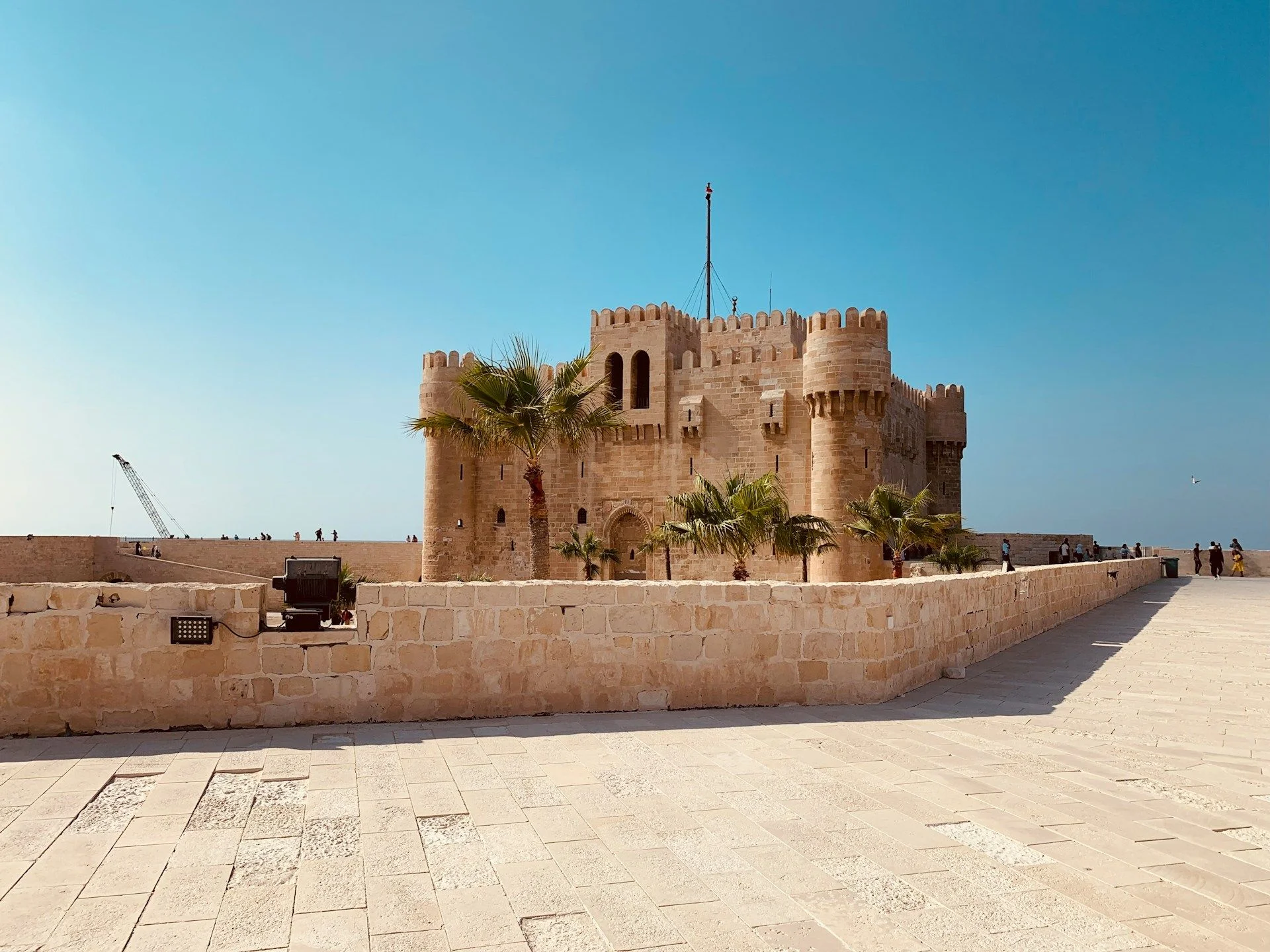Discover Alexandria: Essential Travel Guide & Must-See DestinationsMediterranean heritage, ancient wondersvibrant coastal culture

Advantages of traveling
to Egypt
Pharaonic & Greco-Roman Sites
Stroll through Kom El Dikka’s Roman amphitheatre, explore the Catacombs of Kom El Shoqafa, and marvel at the restored columns of the Serapeum—witness over two millennia of layered history.
Corniche & Mediterranean Beaches
Relax on Mamoura’s sandy shores, swim in the clear waters of Stanley Bay, and dine at waterfront cafés along the Corniche, capturing spectacular sunsets over the sea.
Cultural & Culinary Exploration
Wander historic souks near the Citadel of Qaitbay, sample freshly caught seafood in local fish markets, and enjoy centuries-old recipes at traditional Alexandrian restaurants.
Pharaonic & Greco-Roman Sites
Stroll through Kom El Dikka’s Roman amphitheatre, explore the Catacombs of Kom El Shoqafa, and marvel at the restored columns of the Serapeum—witness over two millennia of layered history.
Corniche & Mediterranean Beaches
Relax on Mamoura’s sandy shores, swim in the clear waters of Stanley Bay, and dine at waterfront cafés along the Corniche, capturing spectacular sunsets over the sea.
Cultural & Culinary Exploration
Wander historic souks near the Citadel of Qaitbay, sample freshly caught seafood in local fish markets, and enjoy centuries-old recipes at traditional Alexandrian restaurants.

Useful articles
and recommendations from experts
Tourism in Alexandria: A Complete Guide
Alexandria, Egypt’s storied port city on the Mediterranean coast, marries ancient grandeur with modern coastal charm. Founded by Alexander the Great in 331 BC, it grew into a nexus of Hellenistic culture, home to the legendary Lighthouse and Great Library. Today, tourism in Alexandria invites visitors to traverse over two millennia of history, from Pharaonic tombs and Greco-Roman ruins to Ottoman citadels and European-style boulevards. Sprawling along the Corniche—an oceanfront promenade dotted with cafés and sunset-view terraces—Alexandria offers refreshing sea breezes, calm beaches, and a vibrant urban spirit. Seamless connections by train from Cairo, a growing network of domestic flights, and well-maintained highways make travel experiences in Alexandria both convenient and compelling. Whether you arrive for a day trip or an extended stay, this guide will help you plan how to visit Alexandria, showcasing the best tours in Alexandria, essential logistics, seasonal patterns, and insider tips to maximize your coastal exploration.
Why Alexandria is Attractive for Travelers
At the heart of tourism in Alexandria lies its unique layering of civilizations. The Catacombs of Kom El Shoqafa—one of the Seven Wonders of the Middle Ages—reveal Hellenistic, Roman, and Pharaonic motifs carved into underground burial chambers. Nearby, Kom El Dikka’s archaeological park features the remains of a 2nd-century Roman amphitheatre and bath complex, illustrating the city’s ancient social life. The Citadel of Qaitbay, a 15th-century fortress built atop the original Pharos Lighthouse’s ruins, offers panoramic views of the harbor and the silhouette of modern vessels passing beneath its ramparts. Museums such as the Graeco-Roman Museum display mosaic floors and statues that illuminate Alexandria’s classical golden age, while the Alexandria National Museum curates Egyptian artifacts spanning the Pharaonic era to the modern republic. This juxtaposition of eras creates a dynamic tapestry that appeals to history enthusiasts, architecture aficionados, and cultural travelers alike.
Beyond its archaeological treasures, Alexandria’s Mediterranean climate and seaside setting bolster its year-round attractiveness. Warm summers moderated by sea breezes and mild winters with ample sunshine support beach tourism at Stanley Beach and Mamoura. The city’s cosmopolitan heritage—shaped by Greek, Italian, French, and British communities—manifests in elegant 19th-century mansions along Fouad Avenue, art deco cinemas, and gourmet cafés serving seafood platters and creamy ice creams. Culinary tourism thrives on local specialties such as Alexandrian fish sandwiches, feta-filled boureks, and sweet basbousa pastries. Lively street markets and contemporary shopping malls cater to diverse tastes, while cultural events—from film screenings at the historic Metro Cinema to music festivals at the Bibliotheca Alexandrina—ensure that Alexandria’s urban fabric remains vibrant. These multifaceted offerings explain why travel experiences in Alexandria continually draw both domestic and international visitors.
Main Types of Tourism in Alexandria
Alexandria supports a spectrum of tourism styles, each unlocking distinct aspects of the city’s heritage and environment. Heritage Tourism covers guided excursions to the Catacombs of Kom El Shoqafa, the Serapeum ruins, and the Roman amphitheatre at Kom El Dikka. Visitors often purchase combined-site tickets and use audio guides or expert Egyptologist services for in-depth interpretation. Museum and Cultural Tourism focuses on the Alexandria National Museum, Graeco-Roman Museum, and modern institutions like the Bibliotheca Alexandrina—home to rotating exhibitions, scientific centers, and a planetarium. Coastal and Beach Tourism revolves around relaxation at Stanley Beach, kitesurfing lessons at the bay, and private yacht charters launched from the marina. Urban and Culinary Tourism features food tours through local fish markets, traditional coffeehouse visits in the Attarine district, and dining at elegant rooftop restaurants overlooking the sea. Event Tourism peaks during summer festivals at the Bibliotheca Alexandrina’s outdoor amphitheatre and December’s International Mediterranean Film Festival, drawing cinephiles and performing-arts enthusiasts. By combining these offerings, travelers customize best tours in Alexandria to suit interests ranging from archaeological immersion to seaside recreation and gastronomic delight.
Unique Attractions and Experiences
Beyond Alexandria’s headline sights, the city boasts lesser-known treasures. The Qaitbay Necropolis—Pharaonic tombs carved into coastal cliffs—offers a glimpse into ancient funerary rites and striking sea views. The Roman-era Pompey’s Pillar (Qawsoun’s Column), at 27 m tall, stands beside the remains of the Temple of Serapis and the late 4th-century Forum. Visitors can ascend narrow staircases inside the column’s base for close-up views of its granite shaft, fluted capitals, and marine horizon. The Catfish Café—floating on a small dock near the Corniche—serves local drinks and provides a tranquil perch for watching fisherman and gulls. In the heart of modern Alexandria, the Alexandria Tramway—one of Africa’s oldest—offers an atmospheric journey through historic neighborhoods. A short ferry ride to Abu Qir Island unveils Ottoman fortifications and remote anchorage, while inland day-trips to Montaza Palace Gardens reveal lush royal parks and private beaches. These unique attractions in Alexandria cater to photographers, history buffs, and leisure travelers seeking authentic experiences beyond guided tours.
Local Logistics and Visitor Regulations
Effective planning for how to visit Alexandria hinges on understanding local logistics. Alexandria is served by Borg El Arab International Airport (HBE), with direct domestic flights from Cairo and overseas connections in select seasons. Budget airlines operate frequent shuttle services to and from Cairo International Airport (CAI), with a drive of roughly 2.5 hours. Intercity trains from Cairo’s Ramses Station—especially the air-conditioned “Silver Star” sleeper—offer a scenic and economical alternative, with first-class compartments available. Within Alexandria, ride-hail apps and meter-ed white taxis provide point-to-point transport; trams on three lines link central districts, with a daily ticket costing just a few Egyptian pounds. Public micro-buses serve longer routes but require familiarity with Arabic place-names.
Visitors should carry a valid passport and, for many nationalities, a visa can be obtained on arrival or via an e-Visa application prior to travel. The local currency is the Egyptian pound (EGP); ATMs are widespread, and credit cards are accepted at major hotels, museums, and restaurants, though cash remains essential for street vendors and small shops. English is commonly spoken in hospitality venues, but learning basic Arabic greetings—“salām” (hello) and “shukran” (thank you)—fosters goodwill. Health recommendations include drinking bottled water in summer and scheduling outdoor activities for early morning or late afternoon to avoid midday heat. When visiting religious sites, modest dress—covering shoulders and knees—is advised. Emergency services are reached via 122 for police and 123 for ambulance. By adhering to these Alexandria travel tips, you ensure respectful, comfortable, and well-organized exploration of the city’s many facets.
Seasonal Demand and Visitor Flows
Alexandria’s visitor patterns reflect both climate and cultural calendars. Peak season spans October to April, when temperatures range from 18 °C to 25 °C, offering ideal conditions for outdoor sightseeing and beach visits without summer humidity. Summer (May–September) sees higher daytime highs—up to 35 °C—but reduced crowding at heritage sites and hotel rates drop significantly, appealing to budget travelers. Ramadan shifts daily rhythms, with daytime fast-eat restrictions but vibrant evening street-food scenes; scheduling pyramid and museum visits before Iftar allows for seamless touring. Major events—such as the Bibliotheca Alexandrina’s International Book Fair in January and the Mediterranean Film Festival in December—attract international delegates, increasing demand for conference-style accommodations and best tours in Alexandria that include festival passes. Weekends (Friday and Saturday) draw domestic visitors from Cairo seeking short coastal breaks, so book accommodations and tours well in advance for Friday overnight stays.
Travel Planning Recommendations
To craft an optimal Alexandria itinerary, begin by securing accommodations at least two months in advance during peak season and festival periods. Select lodging near the Corniche for easy beach access and sunset views or within the Attarine or Latin Quarter for historic ambiance. Book train or flight tickets early, comparing rates between Borg El Arab and Cairo Airport transfers. Reserve guided tours of the Catacombs, Serapeum, and Pompey’s Pillar with reputable Egyptologist-led operators who provide priority-entry passes and small-group experiences. Schedule museum visits and Corniche promenades for early morning or late afternoon to avoid peak sun and crowds. Allocate half-day excursions to the Roman Theatre at Kom El Dikka, followed by seafood lunches at the Fish Market near Qaitbay. For beach days, plan sunrise swims at Stanley Beach and afternoon relaxation at Montaza Gardens, coordinating local taxi or tram travel accordingly. Finally, download offline maps of tram and bus lines, and install translation apps to navigate souks. By following these practical strategies on how to visit Alexandria, you’ll unlock the city’s ancient legacies, coastal delights, and contemporary vibrancy in seamless, unforgettable fashion.
